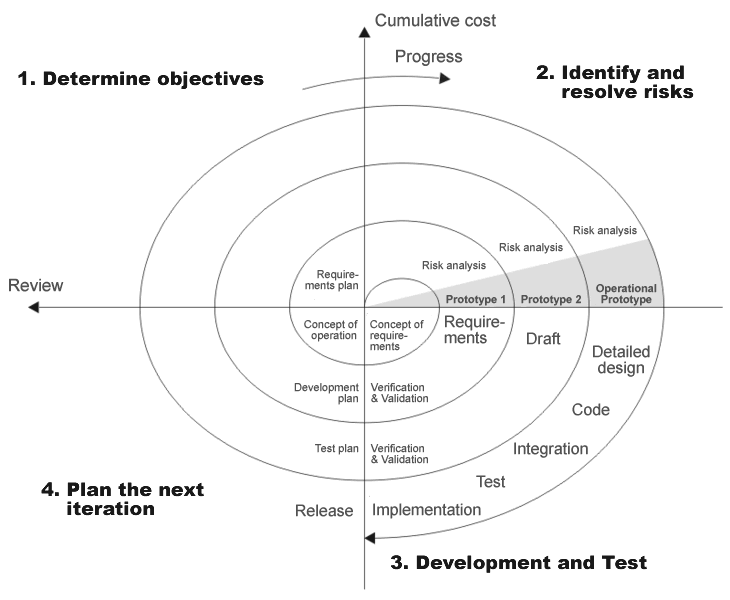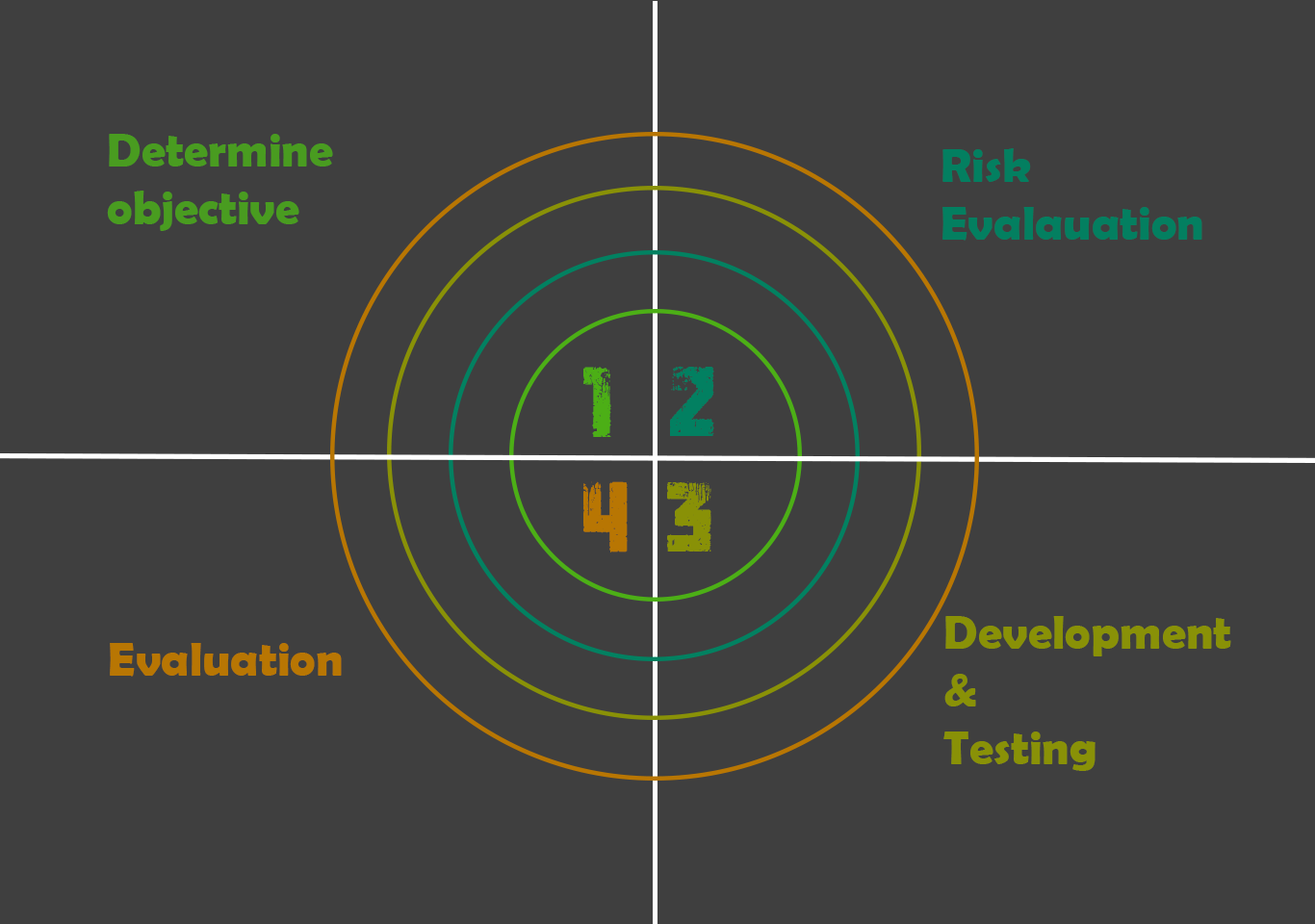Introduction
The spiral model is a software development methodology that combines iterative and waterfall approaches. It focuses on continuous risk evaluation, customer feedback, and prototyping
Barry Boehm, who is an American software engineer has introduced the spiral model in 1986. The spiral model provides support for risk handling. It allows software projects to be developed in cycles or spirals, where each spiral represents a development phase. The development process in the Spiral model in SDLC starts with a small set of requirements and goes through each development phase for that set of requirements. The spiral model has its loops, which are the development phase.
The spiral model is divided into different phases. Each phase gets tested, and errors are tackled. Every phase of this model starts with design objectives and ends with a client review. The client can see how the system is being developed. This model is used for large, expensive, and complicated projects because proper risk assessment is essential. Users can see the system early because of the rapid prototyping feature. Risk evaluation might take a longer time in the system development process. This model can be very complex for small projects. The diagram below represents the spiral model.

Key Characteristics of the Spiral Model
- Risk control is essential to each stage.
- Software is developed iteratively through repeated cycles.
- Building prototypes to gain a better understanding
- Customer Involvement: Ongoing feedback following each spiral
- Flexibility enables to adjust to evolving needs
Spiral Model Phases Explained
Determine objective / Planning
The Phase is the foundational stage of the Spiral Model, laying the groundwork for all succeeding spirals. During this phase, developers collaborate closely with stakeholders to collect system requirements, establish business goals, and define objectives for the current iteration. The planning is not done once at the start of the project; rather, it is examined in each spiral to ensure that evolving requirements and feedback are considered. This phase also entails assessing several viable alternatives and constraints, such as money, technology stack, time constraints, and resources.
Teams prioritize user requirements while developing use cases, feature lists, and high-level designs. Stakeholders are heavily involved, resulting in better alignment between user expectations and actual system development. Good planning ensures an organized approach, increases estimation accuracy, and prevents surprises in the latter stages. This phase generates the iteration goal, a list of activities, dates, and a strategic roadmap.
Risk analysis
The Risk Analysis Phase is what distinguishes the Spiral Model from other software development techniques. During this phase, the development team identifies, analyses, and develops solutions to reduce any risks to the project. These hazards could be attributed to technology, system performance, integration, cost, schedule, or user expectations.
The team starts by listing all potential risk factors. For each identified risk, they assess the likelihood of occurrence, potential impact, and mitigation costs. After risks are analyzed, mitigation solutions are recommended, which may include building prototypes, completing technical feasibility studies, or modifying design decisions.
Prototyping is frequently an important task during this phase, particularly when there are questions about user interface design, technical components, or performance requirements. A working model might be useful for validating assumptions and gathering early feedback. Effective risk analysis helps to avoid costly rework and system failures. It allows for educated decision-making about whether to continue, suspend, or reroute the project.
Development and Testing
The development Phase of the Spiral Model entails the actual development, coding, and testing of the chosen system components based on the results of the Planning and Risk Analysis phases. This phase implements the modified requirements and risk-mitigation techniques through iterative development.
During this phase, developers create the software architecture, write code modules, integrate system components, and run unit tests. The approach is modular, which allows the system to expand gradually. Depending on the project’s complexity and development, developers may create prototypes, Minimum Viable Products (MVPs), or fully functional components.
Testing occurs throughout this step, not just after coding. If a workable deliverable is created, teams will conduct unit testing, integration testing, and potentially acceptance testing. These tests serve to check whether the implementation fits the requirements set during planning and amended after risk assessment. The documentation is updated as necessary to reflect the current stage of development. The result of this phase is a functional module or prototype that is ready for stakeholder review.
Evaluation Phase
During the Evaluation Phase, stakeholders and end-users review, validate, and approve the current spiral’s output. It ensures that each iteration adds value and aligns with the established objectives before moving on to the next spiral. Stakeholders assess prototypes, modules, and deliverables created during the engineering phase. The purpose is to determine whether the system fits the user’s expectations, functional needs, and business objectives.
If a prototype was developed to mitigate a specific risk, its performance and effectiveness are evaluated during this stage. This phase also includes user testing, demonstrations, and structured feedback sessions. All feedback is documented by the development team, who identify any new risks, missed requirements, or necessary revisions. The decision to proceed or not proceed with the following spiral is a critical outcome of the Evaluation Phase. This checkpoint guarantees that each development cycle is completed with clarity, responsibility, and alignment.
When to Use the Spiral Model?
- When a prototype is required.
- When the risk is medium or high.
- When the requirements are not clear.
- When a customer demands an early release.
- This model needs to be used if the project is large and complex.
- When customers request to add more features to the existing system.
- Examples: NASA software system, military system, healthcare, etc.
Advantages and Disadvantages
Advantages
- The prototype is made in each iteration.
- High amount of risk analysis.
- Good for large and mission-critical projects.
- Strong approval and documentation control.
- Additional Functionality can be added at a later date.
- Customer feedback is accepted during development.
- Speeds up development.
- Cost estimation becomes easy.
Disadvantages
- It can be a costly model to use.
- Documentation must be done properly.
- It must be followed strictly by the team.
- Risk analysis requires highly specific expertise.
- The project’s success is highly dependent on the risk analysis phase.
- Doesn’t work well for smaller projects.
- The iteration has no limit, it can go on infinitely until the product is released.
- Difficult in time management


